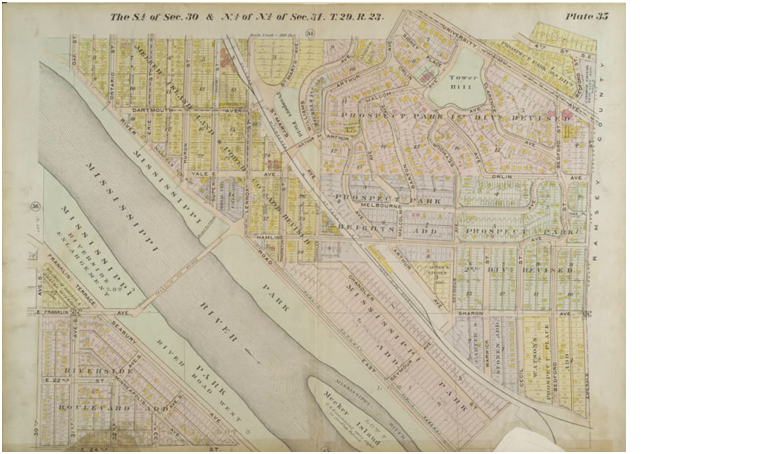It’s map Monday. This plate–from the 1914 real estate atlas for Minneapolis–shows the Prospect Park neighborhood near the Mississippi River. This orderly grid gives no hint of the emotions stirred in this section of the city in 1909, when an African American family purchased three lots at 17 Melbourne Avenue.
William H. Simpson had decided to establish a home in the leafy, middle-class neighborhood at the advice of his friend and fellow Pullman Porter Madison Jackson. Both Jackson and Simpson were African American. Both had good jobs with the railroad, which provided some of the best employment prospects in the Twin Cities for black men at the time. Neighbors grumbled when Jackson had moved his family into the all white neighborhood. But when his friend Simpson decided to do the same thing, they sprang into action.
On October 21, 1909, a crowd of over one hundred residents marched to the Jackson residence, where Simpson was staying to oversee the construction of his new house. There they delivered an unequivocal message to Simpson: members of his race were not welcome in Prospect Park. In the face of threats and insults from the Prospect Park Improvement Association, Simpson held his ground, hoping that residents would come to accept him and his family, as they had Jackson. He continued building and improving his home, investing over $4,000 into the property. Some residents interfered with the process, blocking builders from working on the property. According to the Tribune, these intimidation tactics brought Simpson to the negotiating table with the neighbors, who had organized a corporation to buy him out.
Local clergy proved supportive of Simpson. The pastor at St. James African Methodist Church in St. Paul, the leading black church in the Twin Cities, denounced neighbors from the pulpit as “colossal hypocrites.” Perhaps more surprising was the reaction of the minister of the local Methodist Church, who announced that he would not aid white residents, who were probably some of his parishioners. He told the Minneapolis Tribune that “I am glad if my absence in the gathering of Thursday night was noticeable.”
The Simpsons remained in the Prospect Park home into the 1920s. The small African-American community in Minneapolis did not forget the conflict. When the leader of the white neighbors was nominated for County Attorney the following year, The Twin City Star, an African-American newspaper, reminded its readership of the Simpson house conflict. When the same man was arrested for forgery a year later, the Star reported: “Negro-Hater in the Toils, Prospect Park Agitor in Jail.”
This post was written by Historyapolis intern Derek Waller, who researched the origins of residential segregation in Minneapolis for his January term project at St. Olaf College. Waller is continuing his research into this and other incidents, which he will present as part of a senior capstone paper.
